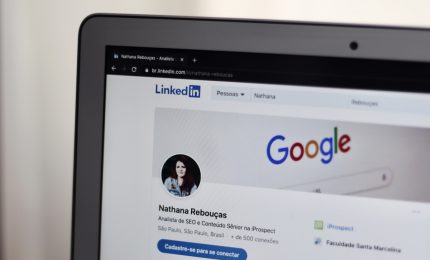LinkedIn is a unique social media network as it specifically caters to businesses and targets professionals—675 million professionals, to be exact. Even with more of a narrowed scope, the platform is still the fifth most popular social media network, based on recent reports. As such, LinkedIn transitioned from a mere professional networking and job-hunting site to a power-player marketing platform that offers a multitude of options for advertising and lead generation.
According to the B2B Content Marketing 2020: Benchmarks, Budgets, and Trends report, marketers say LinkedIn is the platform that generates the best results for both organic and paid social media.
If you want to take advantage of LinkedIn marketing solutions to reach and engage your target audience here are some strategies to consider.
Keep Reading: 5 Pillars of Thought Leadership Strategy
Create Your Business LinkedIn Page
The first step to leveraging LinkedIn marketing solutions is to set up your company page on the platform. Creating a business page on LinkedIn is similar to other social media platforms. Whether you’re new to LinkedIn or your neglected company page has been left collecting dust, follow along to refresh and optimize your presence.
- Logo: Add your company logo as a profile image, make it simple as this will be the small thumbnail that appears on your follower’s feeds.
- Cover image: Add a larger graphic to promote your brand personality. Some companies also choose to include a unique selling point on their cover image. For example, note how Amazon references that potential job candidates should “come build the future” with them.
- Business name and tagline: Business name is straightforward and tagline is a short snippet that describes your business, product, or service. You need to keep it to less than 120 characters, so aim for succinct and informational. (Don’t worry, you can expand on this in your description section.)
- Call-to-action: You get one CTA button that leads to an external site. This would typically be your website but can also point to a landing page for specific campaigns.
- Overview: Here’s where you dive into the details of your business, including industry, company size and type, as well as specialties. Use the description section to elaborate on your organization, products, services, and differentiators; here you have 2,000 characters to play with.,
- Locations: If you have one, add the physical address of your office or business. Note that you can add more than one location, which can help with visibility when users search for nearby or local businesses to find a new vendor, for example.
- Hashtags: You can follow three relevant hashtags as a business. This feature allows you to respond as your business to trending topics. Your page admin will get notifications with opportunities to respond to conversations, so make sure to keep an eye out for those.
Finally, refer to this list of image specifications to make sure you correctly size your graphics. If you miss a section on your page, the platform has a completion meter that highlights missing fields or new features that you can use.
Find and Share Relevant Content
Once you have your profile set up, sharing organic content that garners engagement—and hopefully leads—is one of the more difficult tasks when it comes to LinkedIn. While you can repurpose content from your overall social media and digital strategies, you also need to keep in mind your audience and platform-specific goals. I.E. What do you hope to accomplish via your presence and efforts spent on LinkedIn specifically?
Remember that LinkedIn operates differently than other networks, so before posting, familiarize yourself with its algorithm; this Hootsuite guide breaks it down well. And, because this isn’t a guide on LinkedIn social media marketing, but rather, LinkedIn marketing solutions, we encourage you to refer to this in-depth article from SEMrush for figuring out what to post on LinkedIn: What Will Make You Stand Out on LinkedIn in 2020: The Expert Insights You Need to See.
As you look to find and share content, you may come across content suggestions, which shows you articles and posts trending on the platform that you can share directly to your company page. However, unless you have a large audience (300 or more followers to segment your specific audience, for example) and post several times a day, the tool isn’t all that valuable. If you need help finding relevant, shareable content? Check out our list of the best content discovery tools instead.
Experiment With LinkedIn Ads
While we are huge advocates of organic content marketing at Jessica Thiefels Consulting, we know the value of paid advertising, when done right. As such, we recommend you consider accelerating your growth with paid advertisements on the platform.
LinkedIn marketing solutions offers businesses a few different types of ads. See below for descriptions of each along with screenshots of how they appear in your audience’s feed.
- Sponsored content: These native ads appear in your audience’s LinkedIn feed. They can be articles, videos, or carousel images.
- Sponsored messaging: These ads are sent directly to your audience’s inbox in the form of a direct message.
- Text ads: Similar to PPC or CPM desktops ads on other sites, users will see these ads surrounding their feeds.
- Dynamic ads: Typically tied to a specific campaign, dynamic ads appear on the sidebar of the user’s feed and include a CTA that leads to a landing page or download form.
Wondering how you can create ads that convert? Look at large companies, who you can assume have significant ad budgets (and expert teams), for inspiration. For example, head over to the Salesforce page, and click on the ads option underneath their logo. There you can see all their current sponsored ads and use it to guide your own ad creation.
Measure Your ROI
When it comes to data, LinkedIn offers fairly robust metrics. To start, head to your analytics dashboard to see visitor, posts and follower data to get a clear picture of who you’re talking to and what’s already working. You can also benchmark your organic content by viewing stats specific to each post.
With paid ads, you get access to the LinkedIn campaign manager as well, which offers a dashboard of relevant data related to ad performance.
As with all your marketing efforts, tie your LinkedIn campaigns to real benchmarks that show success in alignment with your overall objectives. Use the metrics on the platforms to test what’s working and what’s not while marrying this with your own data, like website traffic, conversions, downloads, or subscriber growth.
Vanity metrics like follower growth and engagement on LinkedIn are great to track as well, but they don’t automatically represent ROI, so dig deeper and get specific with your goals.
Free Download: Social Media Goal-Setting Template
Use LinkedIn Marketing Solutions to Drive Results
How do you succeed as a B2B organization on LinkedIn? Paul Talbot sums it up nicely to Forbes. “The B2B marketer who approaches LinkedIn as one piece of a multi-channel strategy, sets objectives, allocates appropriate resources, insists on quality content, and weaves all this into the organization’s marketing plan, secures a significant advantage.” Leverage LinkedIn marketing solutions, and all the features available to you as a business, to optimize your presence and drive results.



